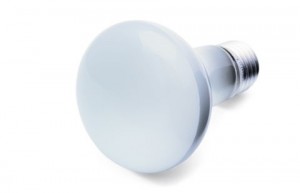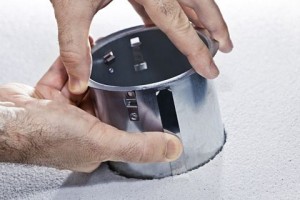Recessed Light Bulbs: Choosing the Right Bulbs for Your Needs
Recessed light bulbs come in a variety of materials, wattages, angles and colors.
Choosing the right recessed light bulbs is important to ensuring you get the right light quality from your overhead lighting. Even if you have them installed professionally, understanding recessed light bulbs will enable you to enter into a conversation with your contractor about the type of bulbs you want in your home.
Recessed Light Bulb Specifications
The first thing that you will want to check when installing your recessed light bulbs are the specifications of the bulb. Every recessed light bulb comes with four specifications: wattage, size, voltage and reflection angle. Depending on your recessed can, you can should use different specifications, or else the bulb will not work properly, and it could be hazardous.In order to check for the specifications that you need, take the trim off of your recessed can. If you look inside, you will see that there are listed maximum wattages and angles inside of your can. These tell you the specifications to look for, assuming you want the maximum illumination from your recessed lighting. You are always free to go under these numbers.
Wattage
Wattage is the amount of electricity that may flow through your bulb. You’ll notice that for most recessed cans, the wattage is far lower than you’d expect from a lamp or pendant. This is mostly because recessed lighting is designed to use multiple cans, so each emits less light. How much illumination you will get from this wattage depends on the type of bulb you use, which I will discuss below.
Bulb Codes
Because recessed light bulbs shine in a single direction, downwards, the light bulbs used are referred to as “reflector bulbs”. Reflector bulbs come in two types. First, there are those simply called “reflector” bulbs, denoted with the prefix “R”. These bulbs have a frosted coating and reflect much of their light in a single direction. There are also “parabolic reflector” bulbs, denoted with the prefix “PAR”. These bulbs use a parabolic base to capture of the light. As a rule, “R” bulbs are less efficient than “PAR” bulbs because of the light that is not properly directed.
The number after the “R” or “PAR” represents the width of the bulb in eights of inches. So, for instance, a PAR16 bulb is 2 inches wide. Typically, the more wattage you use in a bulb, the smaller the bulb must be.

This is a typical reflector (“R”) light bulb. Notice the way that not all light will be reflected forward.
One quick word needs to be said about recessed wall-washing bulbs. Wall washing is when a light is placed near a wall, and it picks up the texture of the wall by shining onto the wall at an angle. This requires the light to be shone downward and to the side. Some wall washers use reflector bulbs with smaller angles. However, others do not use reflector bulbs at all, relying on the housing to reflect the light in the correct direction. If you are using such a wall washer, it will give very specific specifications as to the type of bulb to use on the housing.
Voltage
There are different voltages available for recessed light bulbs. The most common voltages historically have been 120v and 130v light bulbs. Each of these can run on a standard household current (in North America). There are, however, some differences. A 130v light bulb is less efficient than a 120v light bulb, getting less illumination per watt. However, the 130v light bulb will last longer. Which to choose depends on which goal you wish to reach.
On the other hand, there are low-voltage recessed light bulbs. Low-voltage light bulbs produce more illumination per eighth of an inch, allowing you to use more light sources. They are also the standard voltage for LED light bulbs. As a result, low-voltage light bulbs are becoming more common. However, in order to use low-voltage light bulbs, you will need to use a transformer to alter the current. Be sure that you have one installed or are willing to install one should you choose to use low-voltage light bulbs.
Light Bulb Types
There are actually four different types of light bulbs used in recessed lighting. There are traditional incandescent light bulbs, halogen light bulbs, fluorescent light bulbs and LED light bulbs. Incandescent and halogen light bulbs are being used less and less frequently.
Incandescent and Halogen Light Bulbs
Incandescent light bulbs and halogen light bulbs were the standard recessed light sources used up until about twenty years ago. The primary problem with these light bulbs is that they are terribly inefficient. Aside from the environmental and economic impact of this, they also have the effect that they will be substantially dimmer than fluorescent and LED recessed light bulbs. Because you are limited to a certain wattage per fixture and fluorescent and halogen light bulbs get more illumination per watt, you will get far less light with these bulbs.
Halogen light bulbs have a reputation for being more efficient and whiter than incandescent light bulbs. However, this reputation is now largely erroneous. Halogen light bulbs are slightly more efficient and whiter than incandescent bulbs, but they are still far less efficient and white than either fluorescent and LED light bulbs. They were the most efficient and white bulbs available, but this is no longer true by a wide margin.
Fluorescent Light Bulbs
Fluorescent light bulbs have undergone something of a revolution in recent decades. They were well-known as being greenish, having color spikes, flickering and causing noise. All of these problems have now been largely resolved. On top of this, they are about five times more efficient than incandescent light bulbs and four times more efficient than halogen light bulbs. This means that your carbon footprint is reduced, your energy bills are lower and you can have more light per recessed can.
In addition, Fluorescent light bulbs now come in a wide array of colors. Their color spikes have been significantly reduced to the point of being almost unnoticeable. Their colors range from warmer, reddish colors usually called “warm white” or “soft white” that imitate the color of traditional fluorescents up to “cool white” which mimics the slightly bluish light of daylight. This provides a number of options for integrating their color into your home.
LED Light Bulbs
LED light bulbs have only recently become usable in home lighting, and they are now being used increasingly as recessed light bulbs. They are very energy efficient and have the advantage that they do not contain any toxic mercury like fluorescent bulbs do (though recessed lights are generally be shielded from breakage problems). For now, they are more expensive than fluorescent light bulbs, though their price will likely lower in the future.The difficulty with LED light bulbs is color. White LED light bulbs are actually blue light bulbs with a phosphorescent coating to turn that blue light to white. This process is often not entirely successful, and the success can be more or less from diode to diode. As a result, LED lights are somewhere between white and bluish, and you will need to pay more for the whiter colors. However, if you are looking for non-toxic energy efficient lighting on the whiter end of the color spectrum, they are a very good choice. Remember that LED lighting is typically low voltage, so you will need to have a transformer.
Putting It All Together
There are a number of different things to consider when choosing recessed light bulbs:
- Your wattage is limited by the type of recessed can you use.
- Different beam angles will allow your recessed lighting to cover greater or lesser areas.
- The more efficient your bulbs are, the more illumination you will receive.
- Incandescent and halogen light bulbs are neither efficient nor very bright.
- Fluorescent light bulbs are bright and efficient and come in a wide range of colors.
- LED light bulbs are non-toxic, as bright and efficient as fluorescent light bulbs, but are limited to the white-blue part of the color spectrum.
With this information in mind, you will be in a better position to select the recessed light bulbs that are right for you.
Back from Recessed Light Bulbs to Recessed Lighting Fixtures

